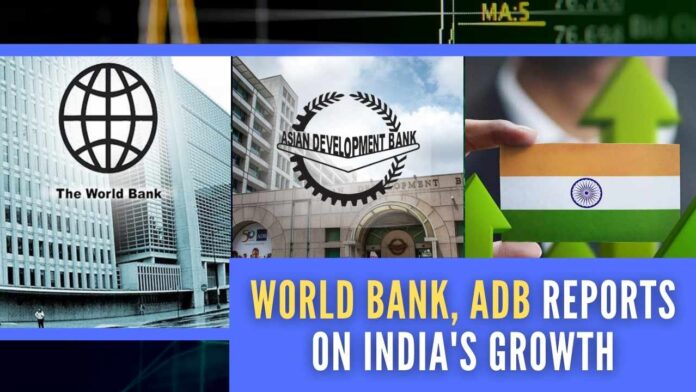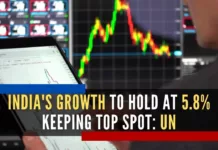
World Bank, ADB reports on India’s growth
The World Bank and the Asian Development Bank (ADB) on Tuesday projected moderation in Indian economic growth between 6.3 percent and 6.4 percent due to a slowdown in consumption and challenging external conditions. The Asian Development Bank (ADB), however, made a slightly optimistic projection of 6.7 percent for FY2024-25 ending March 2025 driven by private consumption and private investment on the back of government policies to improve transport infrastructure, logistics, and the business ecosystem.
The World Bank in its latest ‘India Development Update’ (IDU) slashed the GDP forecast to 6.3 percent against the earlier estimate of 6.6 percent in 2023-24 (FY24). “In India, South Asia’s largest economy, high borrowing costs, and slower income growth are expected to dampen consumption and lower growth to 6.3 percent in FY 2023/ 24,” the World Bank said in a report for South Asia released on Tuesday ahead of the annual spring meeting of the International Monetary Fund and the World Bank.
Growth is likely to be constrained by slower consumption growth and challenging external conditions, it said, adding that government consumption is projected to grow at a slower pace due to the withdrawal of pandemic-related fiscal support measures.
Multi-lateral funding agency Asian Development Bank also said India’s economic growth is expected to moderate to 6.4 percent in the current financial year due to tight monetary conditions and elevated oil prices as compared to a 6.8 percent expansion for the financial year ended March 2023. The projections are part of the latest edition of ADB’s flagship economic publication, Asian Development Outlook (ADO) April 2023.
Echoing ADB’s views, the World Bank report said India was one of the fastest-growing economies in the world despite significant challenges remaining in the global environment. “The Indian economy continues to show strong resilience to external shocks. Notwithstanding external pressures, India’s service exports have continued to increase, and the current-account deficit is narrowing,” said Auguste Tano Kouame, World Bank’s Country Director in India.
Although headline inflation is elevated, it is projected to decline to an average of 5.2 percent in 2023-24, amid easing global commodity prices and some moderation in domestic demand, the IDU said. “The Reserve Bank of India has withdrawn accommodative measures to rein in inflation by hiking the policy interest rate. India’s financial sector also remains strong, buoyed by improvements in asset quality and robust private-sector credit growth,” it said.
The ADB report projected moderation in inflation to 5 percent while Current Account Deficit to 2.2 percent in the current financial year. With regard to inflation, the World Bank Report expects it to ease to 5.2 percent, against 6.6 percent in the current fiscal.
The Government of India is likely to meet its fiscal deficit target of 5.9 percent of GDP in 2023-24 and combined with consolidation in state government deficits, the World Bank report said, the general government deficit is also projected to decline. As a result, the debt-to-GDP ratio is projected to stabilize, it said.
The report also mentioned that except for Bhutan, all countries in the South-Asia region have downgraded their forecasts. Growth in Pakistan, which is still reeling from the impact of last year’s catastrophic floods and facing supply chain disruptions, deteriorating investor confidence, and higher borrowing and input costs, is projected to drop to 0.4 percent this year, assuming agreement on an IMF programme is reached, it said.
In Sri Lanka, GDP is expected to contract by 4.3 percent this year reflecting the lasting impact of the macro-debt crisis, with future growth prospects—following last month’s IMF program approval—heavily dependent on debt restructuring and structural reforms, the bank said. The resumption of tourism and migration has supported growth in Maldives and Nepal. But high external debt and tightened global financial conditions pose risks to Maldives’ fiscal and external accounts, and in Nepal, external shocks, domestic import restrictions, and monetary tightening are expected to hamper growth, said the report.
“South Asia’s economies have been scarred by a combination of extreme shocks over the past three years, and the recovery remains incomplete,” said Martin Raiser, World Bank Vice President for South Asia.
“Countries should use the opportunity of lower energy prices and improving trade balances to move away from ad hoc measures, such as fuel subsidies and import restrictions implemented to address these shocks, and focus on reforms needed to build resilience and boost medium-term growth,” it said.
PGurus is now on Telegram. Click here to join our channel and stay updated with all the latest news and views
For all the latest updates, download PGurus App.
- Defence Minister Rajnath Singh visits Siachen. Reviews military preparedness - April 22, 2024
- Amit Shah’s shares in the Stock Market almost doubled in the past five years - April 21, 2024
- ED accused Rahul wants ED to arrest Kerala Chief Minister, while objecting to the arrests of Delhi and Jharkhand chief ministers - April 21, 2024










